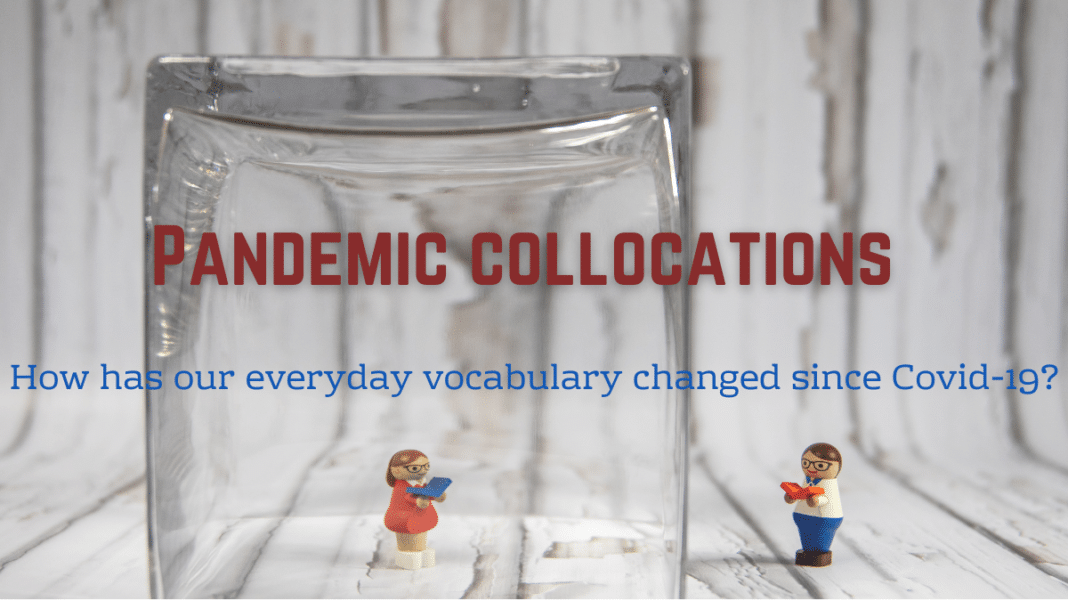The Covid-19 pandemic has changed many aspects of our lives. Language experts know that as the world changes, languages adapt to represent it more accurately. One of the linguistic phenomena that has characterised the pandemic is the emergence of neologisms. Another one is that many words that have always been in our vocabulary are now used in a different way as a result of the pandemic. Indeed, the meanings we give to words can change over time. One way to verify whether such changes have happened over a certain period is to check if word collocations have changed. In other terms, a good way to ascertain the connotations of a word is to look at what other words are often used with it: these words are called collocates.
This article will analyse how the usage of three words has evolved from the pre- to the post-pandemic era. The words selected have been analysed in the Timestamped JSI web corpus 2014-2020. This corpus is made of English news articles collected between 2014 and 2020 and has been judged appropriate for this analysis as its texts are tagged by year and, therefore, allow for the creation of year-specific subcorpora.
The subcorpora chosen for the analysis are the 2018 and the 2020 ones. These subcorpora have been analysed using the Word Sketch Difference function of Sketch Engine. This function makes it possible to check with what words a lemma collocates in two different subcorpora. In fact, for this type of analysis only lemmas could be considered, i.e. all the inflected forms of a word. This means that for nouns the results include plural and singular forms, together with the words in different capitalisation types, while for verbs all tenses and capitalisation types were included.
The words chosen for the analysis are ‘isolation’, ‘restrict’ and ‘contact’. They were chosen because they are common words that have likely acquired new collocates and, therefore, new connotations in consequence of the pandemic.
New scenarios of isolation
For the analysis of the lemma ‘isolation’, the first important piece of data is the number of hits in the two subcorpora selected. Sketch Engine records 468,566 hits in the 2020 subcorpus and only 82,907 hits in the 2018 subcorpus. This means that isolation was discussed much more in news articles in 2020 than in 2018.
In the 2020 subcorpus, ‘isolation’ is often used in conjunction (in “‘isolation’ and/or”) with words such as tracing, distancing, testing, lockdown, containment, confinement, quarantine, separation, hardship and uncertainty, but also with words indicating feelings like stress, anxiety, fear and boredom. Concerning these same words, in the 2018 subcorpus ‘isolation’ collocated with many of them but extremely less frequently compared to the 2020 subcorpus. The reason for this result could be the difference in the number of total hits of ‘isolation’ in the two subcorpora. However, some of the words that have characterised the Covid-19 pandemic are clearly identifiable (tracing, distancing, testing, lockdown and quarantine).
Another interesting result is that, despite the disparity in the number of total hits, the lemma ‘isolation’ is used with similar frequency as a collocate of loneliness, depression, alienation, hopelessness, stigma, deprivation and despair. Additionally, in the 2020 subcorpus, ‘isolation’ is modified mostly by self, managed and tracing, while these modifiers never appear with ‘isolation’ in the 2018 subcorpus. Also, in 2018, you would isolate from noise, while in 2020 you isolated from peer, colleague, and coronavirus. Lastly, ‘isolation’ from family and friend is used approximately three times more in the 2020 subcorpus than in the 2018 one.
From this analysis, it can be deducted that the lemma ‘isolation’ remains associated with negative feelings such as loneliness, alienation, anxiety, fear and boredom. However, in 2020, this lemma was employed more when talking about the pandemic, as demonstrated by the total higher number of hits in the 2020 subcorpus and its collocation with words clearly related to the pandemic (quarantine, lockdown, testing and others).
Restricting as shutting and separating
For the lemma ‘restrict’, the number of hits in the two subcorpora is even greater than it was for ‘isolation’: it appears 203,141 times in the 2018 subcorpus and 275,023 times in the 2020 subcorpus.
In the 2020 subcorpus, ‘restrict’ collocates (in “’restrict’ and/or”) with words like close, cancel, halt, separate and shut. Instead, in the 2018 subcorpus, ‘restrict’ is never employed with these words. Words such as movement, interaction, transport, contact, travel, gathering and spread appear as objects of ‘restrict’ in 2020 news articles more than in 2018.
In 2018 you would restrict smoking, advertising and ownership twice as much as you did in 2020. The frequency of use in both corpora of ‘restrict’ with the objects immigration, freedom, growth and access is very similar in both subcorpora. When it comes to the subjects of ‘restrict’, in the 2020 subcorpus, words such as lockdown, curfew, quarantine, decree, pandemic and Covid-19 register many occurrences, compared to zero occurrences in the 2018 subcorpus.
To sum up, the analysis shows that, in 2020, the lemma ‘restrict’ has become increasingly associated with words related to moving and meeting people, such as movement, contact, travel, interaction, gathering, as well as with words strictly related to the pandemic like lockdown, quarantine and Covid-19. In 2020, restricting means also closing and separating.
The essentiality of contact
The last lemma analysed, ‘contact’ (noun) has 655,884 hits in the 2018 subcorpus and 1,171,719 hits in the 2020 subcorpus. In the 2020 corpus, ‘contact’ collocates with travel, gathering, proximity, testing and droplet in the phrases “contact and” and “contact or”. On the same trend, more mentions of lessening, minimising, reducing, identifying and tracing contact are present in the 2020 subcorpus compared to the 2018 subcorpus. Instead, 2018 articles mentioned initiating contact twice as much as in 2020.
In 2018, contacts were avoidable, deliberate, accidental, consensual, inappropriate, unwanted and sexual many more times than in 2020, when contacts were more unavoidable, necessary, direct, physical, human, face-to-face, close, non-essential and high-risk.
You could “get ‘contact’ without” permission in 2018, while in 2020 you are more likely to “get ‘contact’ without” a mask. Also, you could transmit, spread and infect through ‘contact’ much more often in 2020 than in 2018.
Finally, isolation, self-isolation, quarantine and self-quarantine precede the phrase “after contact” in the 2020 subcorpus, while none of these collocations is registered in the 2018 subcorpus. You deliver and exchange without ‘contact’ in 2020, while that did not seem to be considered in 2018.
Therefore, the lemma ‘contact’ is used nearly twice as much in the articles written in 2020 than in those written in 2018. As could be foreseen, ‘contact’ collocates with words clearly related to the Covid-19 pandemic such as trace, gathering, testing, quarantine, transmit and infect. Compared to 2018, in 2020 articles ‘contact’ is characterised more by adjectives indicating need (unavoidable, necessary, non essential) vicinity (direct, physical, face-to-face, close) and even danger (high-risk).
Isolation, restricting and contacts: same words, updated meanings
To conclude, the analysis of the collocates of the lemmas ‘isolation’, ‘restrict’ and ‘contact’ in the Timestamped JSI web corpus 2014-2020 showed that these have indeed evolved between 2018 and 2020. Consequently, it can be deduced that the meanings of these lemmas have evolved too. Therefore, today, when thinking of isolation, restricting and contacts we are likely to associate these meanings with the pandemic, at least in part. How will these new collocations impact our vocabulary? Nobody can tell for sure, but linguistic change is on the way!
References
Kilgarriff, A., Baisa, V., Bušta, J., Jakubíček, M., Kovář, V., Michelfeit, J., Rychlý, P., Suchomel, V. (2014) ‘The Sketch Engine: ten years on’, Lexicography ASIALEX, 1(1), pp. 7-36, Berlin/ Heidelberg: Springer. doi: https://doi.org/10.1007/s40607-014-0009-9.
Bušta, J., & Herman, O. JSI Newsfeed Corpus. In The 9th International Corpus Linguistics Conference. Corpus Linguistics 2017 Conference, University of Birmingham, 25-28 July 2017.

Written by Maria Bruno, Schuman Trainee at the Terminology Coordination Unit. She holds a master’s degree in Translation and a bachelor’s degree in Italian Language and Literature. She is trained in websites and social media management, content writing and SEO. Currently, she is studying for her Diplôme Universitaire in Terminology at the University of Savoie-Mont Blanc.

